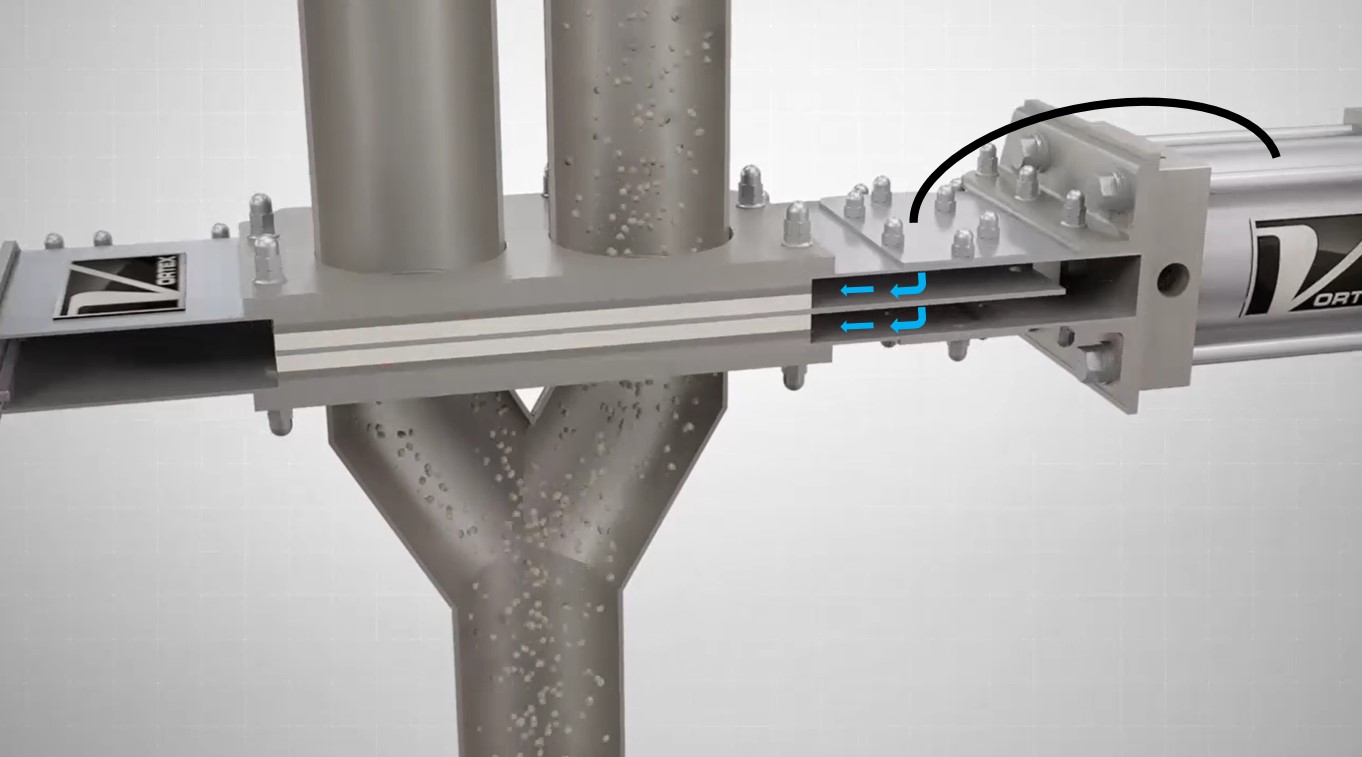
Client:
Quantity:
Size:
Application:
As published in the Bulk Solids Innovation Journal
By its simplest definition, dilute phase conveying is described as “low pressure, high velocity” material movement. Oppositely, dense phase conveying is characterized as “high pressure, low velocity” material movement.

If material characteristics and application parameters permit, dilute phase conveying is often preferred because it can be more energy-efficient and can improve process efficiencies by conveying materials at higher rates of speed. However, many considerations must be made when designing a dilute phase pneumatic conveying process.
This article will address just a few of the considerations that must be made before selecting valves to divert or converge dry materials in dilute phase.
Dilute vs. Dense Phase Pneumatic Conveying

Dilute phase pneumatic conveying primarily is used when processing more stable dry materials. Common examples include plastics, flour, calcium carbonate, grains and hydrated lime powder, among others.
Alternatively, dense phase pneumatic conveying often is used to move more friable dry materials, such as pet food. By transporting such materials at low velocities, there is less risk of degradation as materials move through the convey line.
In addition, dense phase pneumatic conveying often is used when handling highly abrasive materials. By moving abrasive materials at lower velocities, it reduces wear to elbows and other components in the convey line.
Particle Size of Material Handled
Particle size — and, particularly, fine materials — can impact the over-all build of a diverter valve. When handling fine materials, a full-flanged, sealed-body build is necessary to prevent fine materials and dusts from escaping to the atmosphere (Figure 1).
Convey Line Pressures
All Vortex diverters for pneumatic conveying are designed to handle pressures up to 15 psig (0.1 MPa or 1 barg), depending on valve size. Because dilute phase is characterized by low pressure, this pressure rating often is sufficient for a diverter’s application.
However, for higher convey line pressures — those closer to the 15 psig (0.1 MPa or 1 barg) threshold — it is advised to equip the diverter with an air purge assembly (Figure 2). By doing so, the air purge neutralizes any differential pressure that may result from the diverter’s capabilities being challenged. This keeps materials in the flow stream, hindering them from migrating into the valve body.

If convey line pressures exceed 15 psig (0.1 MPa or 1 barg) significantly, one option may be to arrange Vortex HDP Gates or Vortex Titan Pressure Valves (TPV) as process gates used to divert or converge materials. The HDP Gate is designed to handle pressures up to 75 psig (5 barg), depending on gate size, while the TPV is designed to handle pressures up to 100 psig (6.8 barg), also depending on gate size (Figure 3).
Number of Sources and Destinations
Vortex diverters for pneumatic conveying commonly are built with one inlet and two or three outlets. Because the diverters can be oriented in either direction, this allows mate-rial flow from one source toward up to three destinations, or from three sources toward a single destination.
If space is available, some diverters for pneumatic conveying can be stacked to accommodate additional channels. For example, the Vortex Wye Line Diverter and Fill Pass Diverters also can be stacked so that multiple materials can fill into a common weigh hopper (Figure 4).

Replacement to Hose Manifold Stations
If a process requires many sources flow toward many destinations, the Multi-Port Diverter (Figure 5) can reduce overall footprint. Such diverters often are used to replace hose manifold stations and improve process efficiencies through automation.
Available Space
Some diverters, such as the Wye Line Diverter, are benefitted by having a narrow profile. This allows easy installation within most new and pre-existing systems. Others, such as the Flex Tube Diverter, are challenged by limited space installations (Figure 6). This is because it features a large housing to protect its internal flexible hose. As hose length increases, so too does the diverter’s overall height.

Considerations for Materials of Construction
Depending on material type, characteristics can range from nonabrasive to extremely abrasive. This concept is challenged further when handling dry materials in dilute phase, as similar materials can react differently depending on system setup. For this reason, maintenance engineers primarily are concerned with valve longevity and maintenance frequency.
The best way to prevent these concerns is to construct a valve from high-quality, durable materials. Considerations to be made regarding materials of construction include:
Need for abrasion- or corrosion-resistance and how this impacts selected metal type and other modifications. Depending upon the situation, appropriate choices might include several grades of aluminum, 304 and 316L stainless steel, as well carbon steel, among others. For added abrasion-resistance, wrapping the diverter with ceramic backing may make sense (Figure 7).

Whether the diverter will be installed outdoors or in a wash-down environment and how this impacts selected polymer type. When exposed to moisture, nylon has a tendency to swell. If swelling is significant, this can put undue stress on the valve’s blade and cause actuation issues. Alternatively, PET polymer does not swell, which eliminates this concern.
Required ratings and certifications. These include FDA, CE, ATEX, etc.
Handled material temperatures. As a standard, Vortex products can handle material temperatures up to 180°F (82°C). Modifications are available to handle material temperatures up to 400°F (204°C). For especially high-temperature applications, Vortex TPVs may be installed as process gates used to divert or converge. Because the TPV has no polymer seals, it can handle material temperatures up to 660°F (350°C).
Convey line size. Some diverters for pneumatic conveying can be built with larger bores than others. Many can be modified to accommodate specific size requirements.













